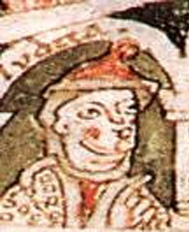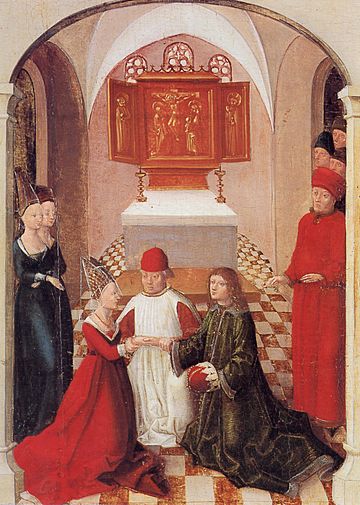Judith of Flanders (died 1095) facts for kids
Quick facts for kids Judith of Flanders |
|
|---|---|
 |
|
| Countess of Northumbria | |
| Tenure | 1055–1066 |
| Duchess of Bavaria | |
| Tenure | 1071–1077 |
| Born | 1032 Bruges |
| Died | 5 March 1095 |
| Burial | Weingarten Abbey |
| Spouse | Tostig Godwinson Welf I, Duke of Bavaria |
| Issue | Welf II, Duke of Bavaria Henry IX, Duke of Bavaria Kunizza of Bavaria |
| House | Flanders |
| Father | Baldwin IV, Count of Flanders |
| Mother | Eleanor of Normandy |
Judith of Flanders (born between 1030 and 1035, died March 5, 1095) was an important noblewoman in medieval Europe. Through her two marriages, she became the Countess of Northumbria in England and later the Duchess of Bavaria in what is now Germany. She was also known for owning many books and beautiful illuminated manuscripts. She gave these valuable items to a monastery called Weingarten Abbey.
Contents
Judith's Family Background
Judith was born in Bruges, a city in Flanders (which is now part of Belgium). She was the only child of Baldwin IV, Count of Flanders and his second wife, Eleanor of Normandy. Eleanor's parents were Richard II of Normandy and Judith of Brittany.
Judith had an older half-brother named Baldwin V, Count of Flanders. He became the Count of Flanders after their father died, which happened when Judith was about two years old. Some historians believe that Judith's father was actually Baldwin V, not Baldwin IV.
Judith's niece was Matilda of Flanders. Matilda married William, who became the first Norman king of England. King William was also Judith's first cousin, as his father, Robert of Normandy, was Judith's maternal uncle.
First Marriage to Tostig Godwinson
Becoming Countess of Northumbria
Before September 1051, Judith married her first husband, Tostig Godwinson. Tostig was the brother of Harold II of England, who would later become King of England.
In September 1051, Judith, Tostig, and his family had to leave England. Tostig's father, Godwin, Earl of Wessex, was sent away by King Edward the Confessor. They went to Bruges, but they were able to return to England the next year.
In 1055, Tostig was made the Earl of Northumbria. This meant Judith became the Countess of Northumbria. Her important marriage to Judith helped Tostig gain this powerful position.
Judith and Tostig had children together, but their names and how many there were are not known. Records say they were very young when their father died.
Judith's Faith and Books
Judith was known as a very religious and curious woman. She showed her faith by giving many gifts to the Church of St Cuthbert in Durham. These gifts included land and a fancy crucifix.
There is a story about the crucifix. St Cuthbert had a rule that women were not allowed inside the cathedral where his holy items were kept. Judith was upset by this rule because she wanted to worship at his tomb. She decided to test the rule. She told her serving woman to go inside first. Judith planned to go herself if the woman returned safely. But as the woman was about to enter the churchyard, a strong, sudden wind hit her. She became sick and eventually died. Because of this scary event, Judith had the special crucifix made for St Cuthbert's shrine.
Throughout her life, Judith collected and ordered many books and beautiful illuminated manuscripts. Some of these books still exist today, like the Gospels of Countess Judith. These books are now kept at the Morgan Library & Museum in New York City. English writers and artists created these books to remember Judith's kindness to the Church.
End of First Marriage
In October 1065, the people of Northumbria rebelled against Tostig's rule. Tostig's brother Harold convinced King Edward to agree to the rebels' demands. This caused a big argument between Tostig and Harold, with Tostig accusing Harold of causing the rebellion.
In November, King Edward declared Tostig an outlaw. Judith, Tostig, and their children had to go to Flanders to stay with her half-brother. In May 1066, after Harold became King of England, Tostig returned to England with a fleet of ships from Flanders. He wanted revenge on his brother. Tostig joined forces with King Harold III of Norway. However, both Tostig and the Norwegian king were killed on September 25, 1066, at the Battle of Stamford Bridge. King Harold's army defeated them.
After Tostig's death, Judith moved to Denmark. It is believed she took her young children with her, but what happened to them later is not known for sure. Less than a month after Tostig died, Judith's brother-in-law, King Harold, was killed at the Battle of Hastings. This battle was fought against the Norman army led by her cousin, Duke William, who then became the King of England.
Second Marriage to Welf I
In 1071, when Judith was 38 years old, she married her second husband, Welf I, Duke of Bavaria. He had divorced his first wife in 1070. When Judith married Welf, she became the Duchess of Bavaria. However, in 1077, her husband lost his title. He did not get it back until 1096, which was a year after Judith died.
Judith and Welf lived mainly at Ravensburg Castle. They had three children together:
- Welf II, Duke of Bavaria (born 1072, died September 24, 1120): He married Matilda of Tuscany, but they did not have any children.
- Henry IX, Duke of Bavaria (born 1074, died December 13, 1126): He married Wulfhild of Saxony and they had seven children.
- Kunizza of Bavaria (died March 6, 1120): She married Frederich Rocho, Count of Diesen.
Judith's Death and Legacy
On March 12, 1094, Judith and her husband listed the gifts they were giving to their family monastery at Weingarten Abbey. Judith died on March 5, 1095, and was buried there. At the abbey, she was mistakenly remembered as a widowed queen of England.
Duke Welf had built the abbey on the Martinsberg in Weingarten, and Judith had supported it. She also gave her amazing library and a holy item said to be Christ's Blood to the abbey. Her husband, Duke Welf, died in 1101 in Cyprus while returning home from the First Crusade.


